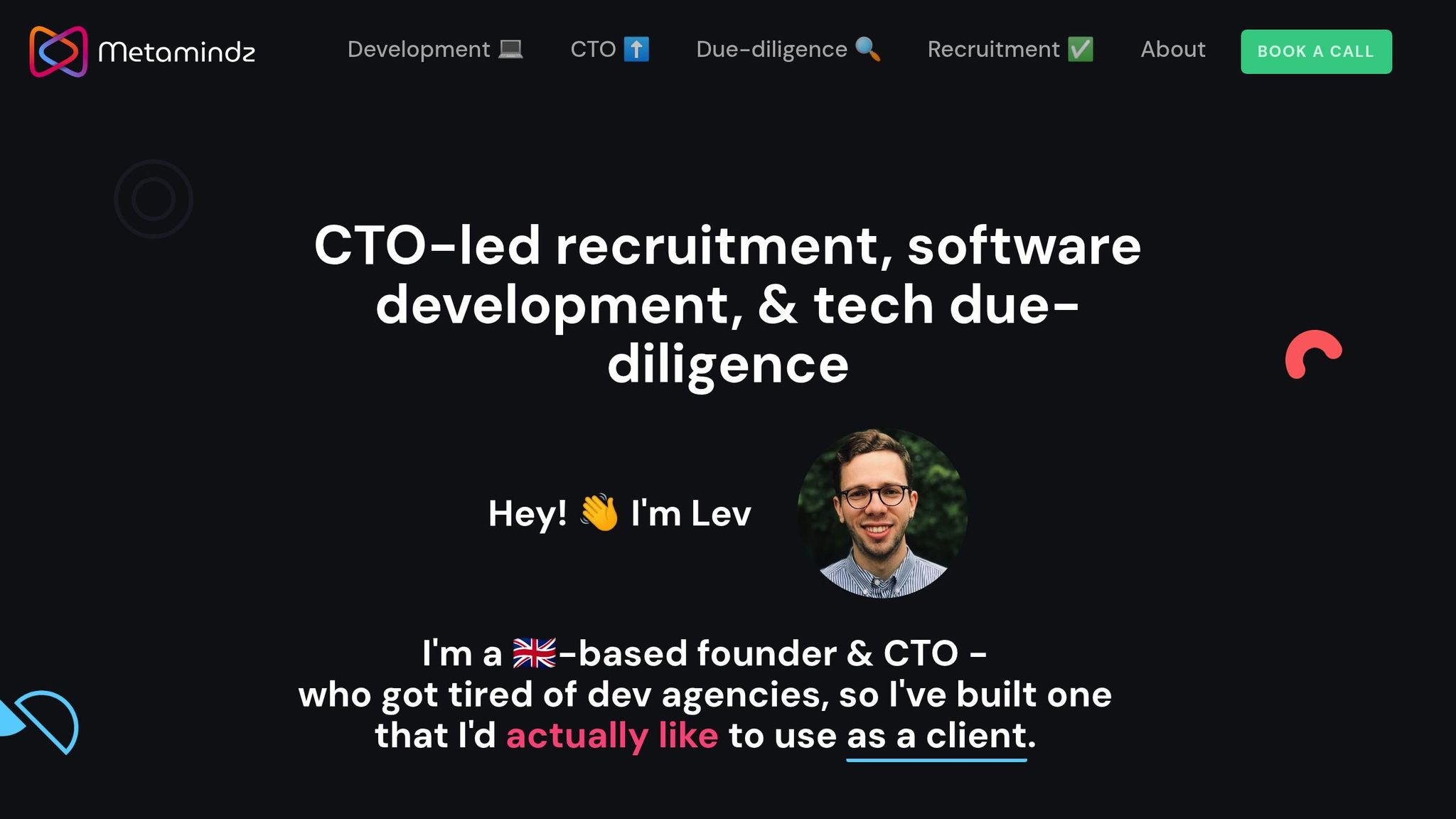Tech Stack Mistakes Startups Should Avoid

Tech Stack Mistakes Startups Should Avoid
Choosing the wrong tech stack can cost your startup time, money, and scalability. Here’s a quick guide to avoid common pitfalls:
- Keep it Simple: Avoid overloading your stack with too many tools. Start with one programming language, one framework, one database, and one cloud provider.
- Plan for Growth: Choose tools that can handle increasing users, data, and performance demands without expensive overhauls.
- Prioritize Security: Secure APIs, encrypt data, enforce strong passwords, and follow compliance standards like GDPR or PCI DSS.
- Ensure Integration: Use tools with APIs, native integrations, and real-time data sharing to avoid system disconnects and inefficiencies.
How to Choose the Right Tech Stack - A Leader’s Guide to ...
Using Too Many Technologies
Having a clear and focused tech stack is essential for long-term growth and managing costs. Jumping into multiple technologies too quickly can lead to unnecessary complexity.
Why a Simple Stack Works Better
Keeping your tech stack simple offers plenty of advantages, especially for startups in their early stages. By sticking to the tools that directly support your business goals, you can:
- Reduce onboarding time for new team members
- Lower infrastructure costs
- Keep codebases cleaner and easier to maintain
- Roll out updates faster and with fewer errors
It's smart to pick tools that can handle multiple needs, so you don’t get stuck relying on overly specialized solutions too soon.
The Downsides of Overcomplicating
Using too many technologies can lead to a range of problems, including:
- Higher maintenance costs from managing multiple systems
- Slower development cycles, extending onboarding and delaying updates
- Increased security risks, as more tools mean more potential vulnerabilities
- Integration headaches when tools don’t work well together
Starting Small: A Smarter Approach
To avoid these pitfalls, focus on building a lean tech stack.
Here’s how to keep it simple:
-
Start with Core Tools
Stick to the basics: one programming language, one framework, one database, and one cloud provider. -
Think Before Adding
Before adopting a new tool, ask yourself: Does it solve a critical issue? Can your current tools handle this need? What will it cost to maintain in the long run? -
Choose Tools That Work Together
Select technologies that integrate easily and have strong community support. This will make scaling and future integrations much easier.
When in doubt, consult experienced technical leaders to determine if a new tool is truly necessary.
Not Planning for Growth
Focusing only on immediate problems often results in temporary fixes that later become major obstacles. These can lead to:
- Technical Debt: Quick fixes that turn into long-term problems.
- Performance Bottlenecks: Systems that struggle to handle increased demand.
- Integration Challenges: Tools that don’t adapt well to expansion.
- Rising Costs: Inefficient workarounds that drive up expenses.
To avoid these pitfalls, it’s crucial to address both current needs and future growth requirements.
Immediate vs. Future Needs
Finding the right balance between addressing today’s challenges and planning for tomorrow’s scalability is essential. Without this balance, startups risk expensive, last-minute fixes when their systems fail to keep up with growing demands.
Measuring Tool Scalability
To align with your long-term goals, evaluate every tool’s ability to scale. Consider these key factors:
| Scalability Factor | Key Metrics to Consider | Potential Issues |
|---|---|---|
| Performance | Response time, throughput | Slower performance as demand grows |
| Data Volume | Storage capacity, query speed | Inefficiency with larger datasets |
| User Load | Concurrent user capacity | Overloaded memory or CPU usage |
| Integration | API capabilities, third-party dependencies | Delays in system communication |
How to Assess Scalability
Here’s how to ensure your tools can grow with your business:
-
Run Load Tests
Simulate real-world user activity to uncover weak points before they become critical problems. -
Examine Architecture Constraints
Look for limitations like database connection caps, API rate limits, or storage restrictions that could hinder growth. -
Estimate Growth Costs
Analyze how scaling will impact expenses, including infrastructure, storage, and processing costs as your user base expands.
When choosing tools, opt for those with a proven ability to handle growth. Look for technologies that offer clear upgrade options and the flexibility to adapt as your startup evolves. Planning for scalability now can save you from expensive system overhauls later.
sbb-itb-fe42743
Missing Security Basics
When your startup begins to grow, securing your systems from the start is just as important as picking the right tools. Overlooking security during early tech stack decisions can weaken your startup's foundation. Building security into your processes from day one helps protect your operations and ensures long-term stability.
Early Security Mistakes
Startups often face security issues when speed takes precedence over caution. Here are some common missteps and how to avoid them:
| Security Mistake | Impact | Prevention Strategy |
|---|---|---|
| Unsecured APIs | Data breaches and unauthorized access | Use API authentication and rate limiting |
| Default Configurations | Exploits due to known vulnerabilities | Customize settings and perform regular updates |
| Weak Password Policies | Account compromises | Require strong passwords and enable multi-factor authentication |
| Unencrypted Data Storage | Data theft and compliance violations | Encrypt data both at rest and in transit |
| Missing Access Controls | Internal threats and data leaks | Use role-based access control (RBAC) |
Security Best Practices
To build a secure foundation, integrate these measures into your tech stack from the start:
-
Authentication and Authorization
Use trusted identity management providers to secure access without the need for custom solutions. -
Data Protection
Encrypt sensitive information with AES-256 for data at rest and TLS 1.3 for data in transit. Always store encryption keys separately for added security. -
Monitoring and Logging
Adopt reliable tools for logging and monitoring to detect incidents in real time and maintain system transparency.
Meeting Compliance Standards
Every industry and region has specific compliance rules that your tech stack must address. Here's a quick overview:
| Regulation | Key Requirements | Tech Stack Implications |
|---|---|---|
| GDPR | Data privacy and user consent | Enforce encryption and strict access controls |
| HIPAA | Healthcare data protection | Maintain audit trails and secure data storage |
| PCI DSS | Payment data security | Use network segmentation and strong encryption |
| SOC 2 | System security controls | Implement continuous monitoring and access management |
To stay compliant, keep thorough documentation, schedule regular security audits, and ensure all third-party tools align with the required standards.
Disconnected Tools
When tools in your tech stack don’t work together, it creates unnecessary friction that slows down your startup’s progress. Integration isn’t just a nice-to-have; it’s essential for keeping your systems efficient and easy to manage as you grow.
Why Tool Isolation Hurts
When tools operate in isolation, it leads to several problems. Manual data entry becomes a time sink and increases the risk of errors. Delays in reporting can prevent timely decisions, and inconsistent data may harm customer service. To avoid these issues, ensure all your systems - whether it’s your CRM or version control software - are connected and share data seamlessly.
How to Choose Tools That Work Together
Picking tools that integrate well can simplify your workflows and help you maintain a scalable system. Focus on these key features:
- API Availability: Tools with well-documented RESTful APIs make integration easier.
- Native Integrations: Look for platforms that already offer built-in connections to the tools you use.
- Webhook Support: Tools that provide real-time event notifications help keep data synchronized.
- Data Format Compatibility: Ensure tools can share data in standard formats like JSON or XML without requiring complex conversions.
A Practical Integration Example
Take an e-commerce startup as an example. Here’s how integration can transform operations:
-
Order Management
The order system updates inventory, sends shipping notifications, and syncs customer information across platforms automatically. -
Customer Support
Support tools pull in order histories, payment details, and shipping updates, giving agents a complete view of customer interactions. -
Analytics and Reporting
Data on sales, customer behavior, and inventory is fed into unified dashboards, enabling quick, informed decisions.
A connected toolset not only boosts efficiency but also sets the stage for smoother growth in the future.
Conclusion: Building Better Tech Stacks
Key Takeaways
Avoiding mistakes in your tech stack starts with careful planning. The focus should be on keeping things simple while ensuring your setup can grow with your business. A strong tech stack emphasizes integration, security, and scalability. By choosing tools that work well together, you can avoid unnecessary complications and system disconnects.
Security and scalability should be priorities from the very beginning. This means picking tools that meet your current needs while setting a solid foundation for future growth. Following these principles can help you sidestep common challenges and support smoother expansion.
Metamindz Services

Once these basics are in place, expert guidance can help fine-tune your tech stack for better results. For startups building or improving their tech stack, having experienced technical leadership can help avoid common errors and simplify the process.
Industry leaders have praised Metamindz for its approach:
"Metamindz manifests intricate analytical skills, deep technological capabilities and above all, high accountability." – Erez, Avante [1]
Metamindz offers fractional CTO services starting at £2,750 per month, giving startups access to experienced technical leadership without needing a full-time hire. This flexible option has been a game-changer for early-stage companies laying down their technical groundwork. Additionally, their technical assessment services can uncover potential problems before they become major issues. For example, in March 2025, Metamindz released the article "Building Scalable E-commerce: Architecture Best Practices," which has become a go-to resource for startups in the e-commerce industry [1].
